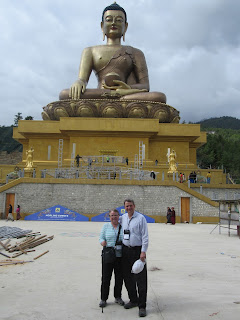We started the day with a
presentation on Gross National Happiness (GNH) by Mr. Norbu Wangchuk. GNH seeks
to measure not momentary happiness, but deep, enduring and abiding happiness
that comes from multi-dimensional life experiences. The policy goal is a
harmonious balance among material well-being and the spiritual, emotional and
cultural needs of society.
The four pillars of GNH are as
follows:
1. Sustainable
and equitable socio-economic development
2. Preservation
and promotion of culture
a.
Strengthen family ties
b.
Promote mediation
3. Conservation
of the environment
a.
60% of the country under forest cover
b.
Carbon neutral
4. Good
governance
a.
Trust in media
b.
Fighting corruption
A GNH index is created based on 124 variables in
the following categories:
1. Psychological
well-being
2. Health
3. Time
use – work, leisure, sleep
4. Education
5. Cultural
diversity and resilience
6. Good
governance
7. Community
vitality
8. Ecological
diversity and resilience
9. Living
standards – assets, housing, household income
A survey is conducted every 2-4
years and the resulting GNH index is used for planning and policy development.
A four-point scale is used to
evaluate whether a proposed policy will increase or reduce stress. The scale is
as follows:
1. Will
increase stress
2. Do
not know the effect on stress
3. Stress-neutral
4. Will
reduce stress
The first two are viewed as
unfavorable and the latter two are viewed as favorable. The result is a
comprehensive measure of progress.
“All joy in this world comes from
wanting others to be happy. All suffering comes from wanting only oneself to be
happy.” – Shanti Deva
My weather app called for a 60% chance
of rain in the afternoon, and apparently Raaz’s did, too. We boarded the bus
for the world’s largest, outdoor seated Buddha. We wanted to see the Buddha before it rained. This statue has eclipsed the
one in Hong Kong that Abby and I had seen in 2003.
We walked up the stairs and
entered the temple inside the Buddha’s “throne,” after removing our hats and
shoes. No photographs were allowed inside. The temple is designed to contain
thousands of small statues of Buddha; dozens of them were in place already, even though the site is still under construction. There was a throne inside, on which a picture of the head abbot of the
Bhutanese Buddhist religion rested.
Back outside, we walked around
the base of the Buddha's throne. Buddhist images in high relief projected from the walls
– horses, peacocks, elephants, and a man with cymbals. The temple was
surrounded by golden statues of female attendants. From the road outside the temple
was a great view of the city of Thimphu. In the distance we could see the Tashicho
Dzong, the great fortress built in the 17th century to defend the
city. This is one of a chain of dzongs built by Zhabdrung Ngawang Namgyel to
secure the country.
Our next stop was the farmers’
market, where a vast variety of grains, vegetables, and dried fish are sold. To
my amazement, the vendors spoke good English. We asked one about a large fruit
that looked like a cross between a squash and a cucumber. The vendor said it
was more like a cucumber, though not exactly. I took photographs of various
squashes and peppers that did not look like those we see in the United States.
We then stopped by the national
archery competition, but only in time to see one arrow be shot before the competition ended for the day. We would stop
by again the next day to see more of the Bhutanese national sport.
We then drove to a restaurant and
gift shop called Simply Bhutan. Here we would have lunch and be treated to a
dance concert of various types of Bhutanese traditional dance. But first we
passed a rather startling display of male fertility symbols. We were served
bowls of Ara, the traditional Bhutanese liquor. Raaz described it as similar to
the Japanese drink, sake, and I was inclined to agree. The beverage carries a
reddish-orange color that comes from being cured in sandalwood. We ended with a
dance not unlike the hora, where we stood in a circle and danced in and out
with a kick at the end. It was great fun.
We drove to the Tashicho Dzong,
the fortress that is both monastery and seat of government. Sonam and Kun
demonstrated the additional garment, a kind of beige shawl, that they are
required to wear with their traditional Bhutanese attire while inside the
dzong. We did see monks walking around inside the dzong, and could hear monks
chanting and playing horns in one of the buildings we were not allowed to
enter. The younger monks walked by carrying buckets and doing chores.
We took our shoes and hats off to
enter the main temple. No photos allowed. We proceeded in a clockwise fashion
around the inside. We came up on three monks making a decoration for the altar
out of different colors of paste made from flour. A young monk who looked to be
about 11 years old wandered around. We admired the large statue of the Buddha
in the front of the temple. In front of the Buddha was a throne for the chief
abbot, and a similarly majestic seat for the king. On either side were lesser
seats for the various ministers. There is little separation between state and
religion in this country. We took a brief tour of the courtyard and then headed
back to the hotel.




No comments:
Post a Comment